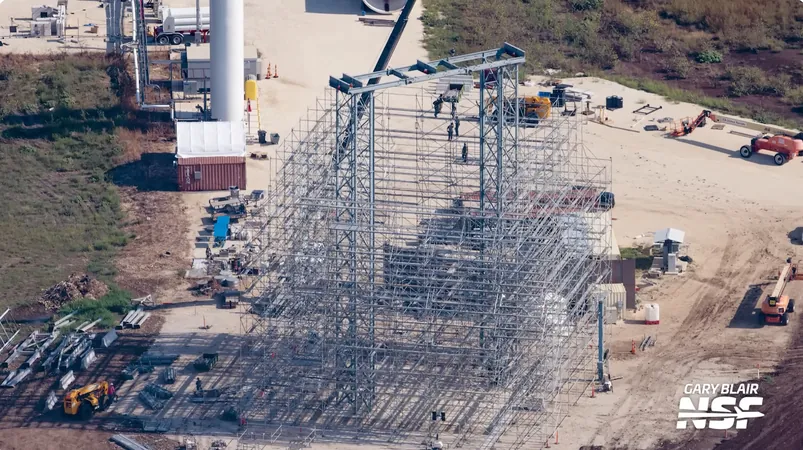
Revolutionary DNA Test Unveils Secrets of Carbon Storage in Plant Roots
2025-09-02
Author: Jacob
Unlocking the Underground: The Hidden World of Plant Roots
Did you know that the roots beneath your feet play a massive role in climate stability and food production? For too long, these underground heroes have been elusive, but researchers at Aarhus University have developed a groundbreaking method to finally unveil their secrets. This innovative technique acts like a "DNA test for soil," allowing scientists to accurately measure root biomass and carbon storage levels of different plant species.
Why Roots Matter More Than You Think
While we often admire the above-ground beauty of plants—wheat swaying in the breeze or vibrant clover carpets—the real magic happens below. Roots not only anchor plants and nourish them with vital nutrients but also play a crucial role in carbon retention. For decades, accurately measuring the mass of these hidden roots has posed a significant challenge to researchers.
Henrik Brinch-Pedersen, a professor at Aarhus University, likens this challenge to studying marine life without ever diving into the ocean. Until recently, the primary method involved laboriously digging up soil, washing and weighing the roots—an inefficient process that often destroyed the finest, most important roots.
A Breakthrough in Measurement: The Power of DNA Technology
Enter droplet digital PCR (ddPCR). Instead of invasive sampling, this cutting-edge DNA technology segments a soil sample into thousands of tiny droplets, assessing each for species-specific DNA. Using a unique genetic marker, known as ITS2, researchers can identify which roots are present and quantify their biomass without disturbing the soil.
Brinch-Pedersen describes the technique as akin to giving soil a "DNA test," allowing scientists to visualize underground biodiversity and carbon storage without heavy excavation.
A Methodology That Earned International Acclaim
This innovative research team, featuring Nurbanu Shynggyskyzy, Claus Krogh Madsen, and others, has already gained international recognition. Their study in the acclaimed journal Plant Physiology highlights a significant leap forward in root analysis.
Applications That Could Change Agriculture Forever
What’s next for this revolutionary method? Its potential applications are vast:
1. **Climate Research**: By accurately measuring how different crops store carbon in the soil, the agriculture sector can bolster its impact against climate change.
2. **Plant Breeding**: Researchers can now focus on breeding plant varieties that efficiently channel biomass underground without compromising above-ground yields.
3. **Biodiversity Studies**: For the first time, the dynamic interactions among species underground can be observed, offering insights into how they compete and cooperate.
Roots: The Unsung Heroes of Climate Solutions
It’s becoming increasingly clear that while we often think of technology like wind turbines as climate savers, plant root systems are vital players in biological carbon storage. As plants grow, they absorb CO₂, storing parts of it in their roots for decades or even centuries. The potential for sustainable cropping systems that optimize this natural process is enormous.
Challenges Ahead but Optimism Abounds
Of course, this method isn’t without its challenges. Some species with closely related DNA, such as ryegrass and Italian ryegrass, can be tricky to differentiate. Nonetheless, the success of the initial tests lays a solid foundation for expanding a DNA library to measure even more plant species directly in soil samples.
The days of laborious fieldwork are giving way to rapid, precise analysis, allowing researchers to shine a light into an underground world that has long remained a mystery. With this new technology in hand, the future of agriculture and climate research is looking brighter than ever.









 Brasil (PT)
Brasil (PT)
 Canada (EN)
Canada (EN)
 Chile (ES)
Chile (ES)
 Česko (CS)
Česko (CS)
 대한민국 (KO)
대한민국 (KO)
 España (ES)
España (ES)
 France (FR)
France (FR)
 Hong Kong (EN)
Hong Kong (EN)
 Italia (IT)
Italia (IT)
 日本 (JA)
日本 (JA)
 Magyarország (HU)
Magyarország (HU)
 Norge (NO)
Norge (NO)
 Polska (PL)
Polska (PL)
 Schweiz (DE)
Schweiz (DE)
 Singapore (EN)
Singapore (EN)
 Sverige (SV)
Sverige (SV)
 Suomi (FI)
Suomi (FI)
 Türkiye (TR)
Türkiye (TR)
 الإمارات العربية المتحدة (AR)
الإمارات العربية المتحدة (AR)